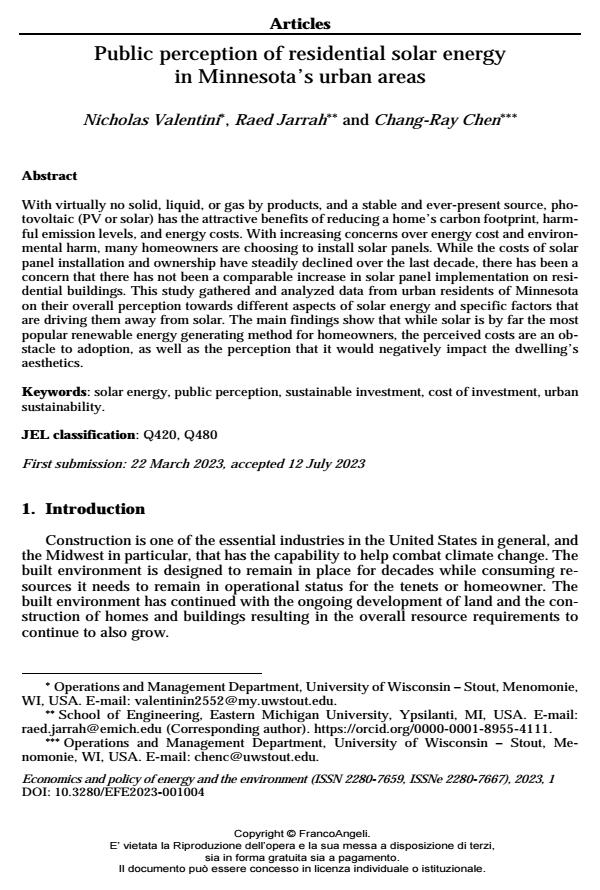Public perception of residential solar energy in Minnesota’s urban areas
Titolo Rivista ECONOMICS AND POLICY OF ENERGY AND THE ENVIRONMENT
Autori/Curatori Nicholas Valentini, Raed Jarrah, Chang-Ray Chen
Anno di pubblicazione 2023 Fascicolo 2023/1
Lingua Inglese Numero pagine 83 P. 61-23 Dimensione file 326 KB
DOI 10.3280/EFE2023-001004
Il DOI è il codice a barre della proprietà intellettuale: per saperne di più
clicca qui
Qui sotto puoi vedere in anteprima la prima pagina di questo articolo.
Se questo articolo ti interessa, lo puoi acquistare (e scaricare in formato pdf) seguendo le facili indicazioni per acquistare il download credit. Acquista Download Credits per scaricare questo Articolo in formato PDF

FrancoAngeli è membro della Publishers International Linking Association, Inc (PILA)associazione indipendente e non profit per facilitare (attraverso i servizi tecnologici implementati da CrossRef.org) l’accesso degli studiosi ai contenuti digitali nelle pubblicazioni professionali e scientifiche
With virtually no solid, liquid, or gas by products, and a stable and ever-present source, pho- tovoltaic (PV or solar) has the attractive benefits of reducing a home’s carbon footprint, harm- ful emission levels, and energy costs. With increasing concerns over energy cost and environ- mental harm, many homeowners are choosing to install solar panels. While the costs of solar panel installation and ownership have steadily declined over the last decade, there has been a concern that there has not been a comparable increase in solar panel implementation on resi- dential buildings. This study gathered and analyzed data from urban residents of Minnesota on their overall perception towards different aspects of solar energy and specific factors that are driving them away from solar. The main findings show that while solar is by far the most popular renewable energy generating method for homeowners, the perceived costs are an ob- stacle to adoption, as well as the perception that it would negatively impact the dwelling’s aesthetics.
Parole chiave:solar energy, public perception, sustainable investment, cost of investment, urban sustainability.
Jel codes:Q420, Q480
- Proceedings of the Third ICMDS'24: Machine Learning, Inverse Problems and Related Fields Mohamed Amine Ouhinou, Abdellah Saoualih, Soufiane Lyaqini, Salah Eddine Kartobi, Stoyan Prodanov, Larbi Safaa, pp.193 (ISBN:978-3-031-94801-5)
Nicholas Valentini, Raed Jarrah, Chang-Ray Chen, Public perception of residential solar energy in Minnesota’s urban areas in "ECONOMICS AND POLICY OF ENERGY AND THE ENVIRONMENT" 1/2023, pp 61-23, DOI: 10.3280/EFE2023-001004